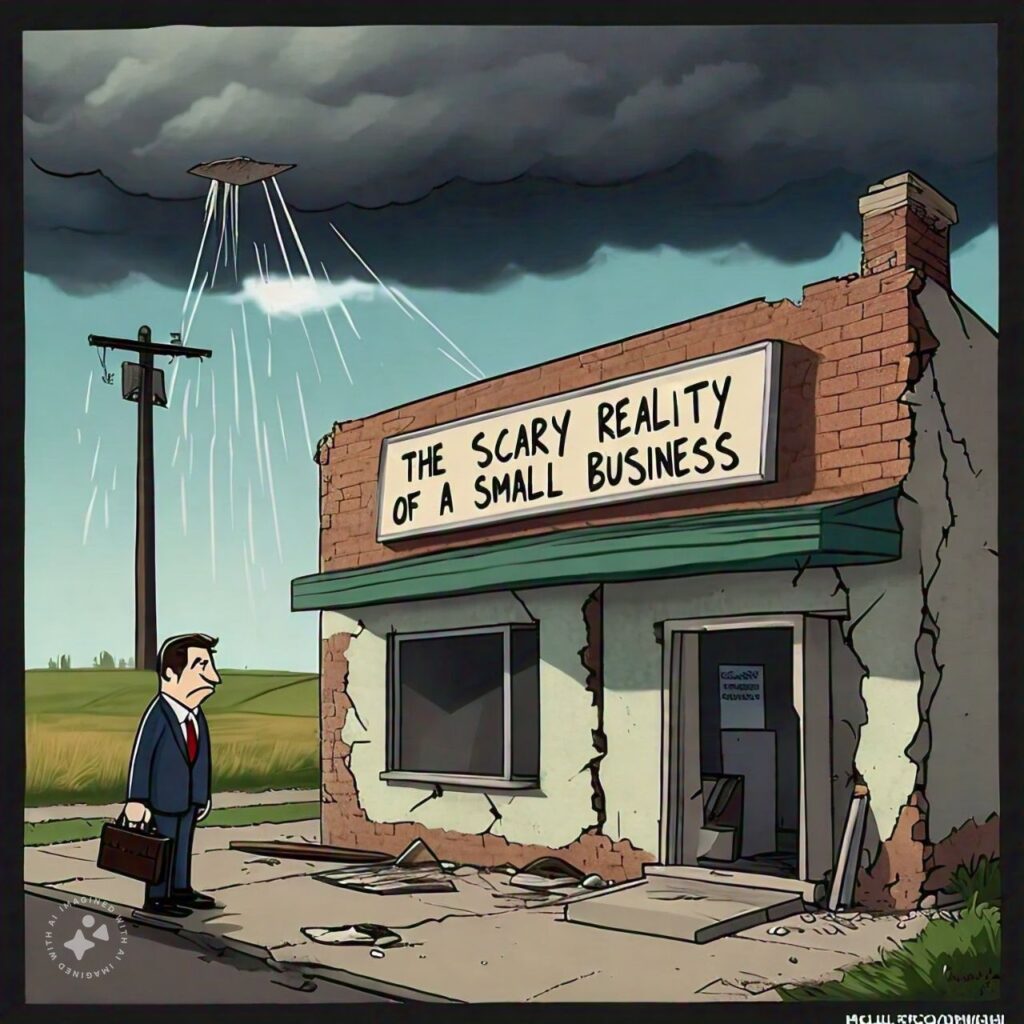Have you ever wondered why so many small businesses fail? It’s a disheartening statistic: 50% of new businesses close their doors within their first year, and a staggering 75% don’t make it past five years. But what if there’s a way to beat these odds?
In this blog post, we’ll delve into the insights from Michael E. Gerber’s book, The E-Myth Revisited, to understand why many small businesses struggle and how you can build a thriving enterprise.
The Fatal Assumption

Many aspiring entrepreneurs make a critical mistake: they assume that their technical skills are enough to run a successful business. Just because you’re a skilled accountant, for example, doesn’t mean you’ll automatically excel at managing an accounting firm. This misconception can lead to significant challenges and ultimately, failure. This is often referred to as the “fatal assumption.”
Understanding the Difference
While technical skills are undoubtedly valuable, they’re just one piece of the puzzle. There’s a significant difference between understanding the technical aspects of a business and knowing how to manage and grow that business as a whole.
The Technician’s Perspective
A technician is focused on the day-to-day tasks and operations. They excel at doing the work, but may struggle with strategic planning, leadership, and overall business management.
The Entrepreneur’s Perspective
An entrepreneur, on the other hand, sees the bigger picture. They are visionary leaders who understand the market, competitors, and the overall direction of the business. They focus on strategic planning, resource allocation, and building a sustainable enterprise.
The Dangers of the Fatal Assumption
When entrepreneurs fall prey to the fatal assumption, they often neglect the crucial managerial and entrepreneurial aspects of their business. This can lead to several pitfalls:
- Overwork and Burnout: The owner may become overwhelmed by the sheer volume of tasks, leading to burnout and decreased productivity.
- Missed Opportunities: A lack of strategic thinking can prevent the business from capitalizing on growth opportunities or adapting to changing market conditions.
- Financial Difficulties: Poor financial management, often a result of neglecting this critical area, can lead to cash flow problems and even bankruptcy.
- Employee Dissatisfaction: A lack of clear leadership and direction can lead to low morale and high turnover among employees.
Avoiding the Fatal Assumption
To avoid falling victim to the fatal assumption, it’s essential to recognize the limitations of your technical skills and seek out the necessary support. This might involve:
- Hiring a Business Advisor: A professional advisor can provide guidance on strategic planning, financial management, and other key areas of business.
- Taking Business Courses: Enrolling in business courses can help you develop the necessary skills and knowledge to run a successful enterprise.
- Networking with Other Entrepreneurs: Connecting with experienced entrepreneurs can offer valuable insights and advice.
By acknowledging the importance of both technical expertise and business management, entrepreneurs can position themselves for long-term success and avoid the pitfalls of the fatal assumption.
The Entrepreneur, Manager, and Technician

Every business owner wears three hats: the entrepreneur, the manager, and the technician. The entrepreneur is the visionary, the manager ensures smooth operations, and the technician handles the day-to-day tasks. The key to success lies in balancing these roles effectively.
The Entrepreneur
- The Visionary: The entrepreneur is the dreamer who envisions the future of the business. They are often passionate about their product or service and have a clear idea of where they want to take the company.
- The Risk-Taker: Entrepreneurs are willing to take calculated risks to achieve their goals. They are not afraid to step outside their comfort zone and try new things.
- The Innovator: Entrepreneurs are often innovators who come up with new ideas and ways of doing things. They are always looking for ways to improve their products or services and stay ahead of the competition.
The Manager
- The Organizer: The manager is responsible for the day-to-day operations of the business. They ensure that tasks are completed, deadlines are met, and resources are allocated efficiently.
- The Problem-Solver: Managers are skilled at identifying and resolving problems that may arise. They are also responsible for developing and implementing strategies to improve the business’s performance.
- The Leader: Managers play a crucial role in leading and motivating employees. They create a positive work environment and ensure that employees are aligned with the company’s goals.
The Technician
- The Expert: The technician is the expert in the technical aspects of the business. They have the skills and knowledge to perform the necessary tasks to keep the business running smoothly.
- The Implementer: Technicians are responsible for carrying out the plans and strategies developed by the entrepreneur and manager.
- The Detail-Oriented: Technicians are often highly detail-oriented and focused on accuracy and precision.
Balancing the Roles
While each role is important, it’s essential to maintain a balance between the entrepreneur, manager, and technician. An overly focused entrepreneur may neglect the operational details, while a manager who is too focused on efficiency may stifle innovation. A technician who is too focused on their tasks may lose sight of the bigger picture.
The ideal situation is for the entrepreneur to provide the vision and direction, the manager to ensure smooth operations, and the technician to execute the tasks. By working together effectively, these three roles can help a business achieve its goals and succeed in the long run.
The Three Phases of a Business

As businesses evolve, they typically go through three distinct phases: infancy, adolescence, and maturity. Understanding these phases can help entrepreneurs anticipate the challenges and opportunities that lie ahead.
1. Infancy: The Newborn Stage
- Characteristics:
- New business, often started by a single entrepreneur or a small team.
- Focus on establishing a presence in the market and generating initial sales.
- Limited resources and a high level of involvement from the owner.
- Challenges:
- Cash flow management: Balancing expenses with income can be difficult, especially during the early stages.
- Marketing and sales: Building a customer base and generating awareness can be challenging.
- Operational efficiency: Lack of systems and processes can lead to inefficiencies and errors.
- Opportunities:
- Flexibility: Small businesses can be nimble and adapt quickly to changing market conditions.
- Personal touch: Direct interaction with customers can foster strong relationships.
- Innovation: New businesses often have the freedom to experiment and innovate.
2. Adolescence: The Growing Pains
- Characteristics:
- Business is expanding and growing rapidly.
- Increased demand for resources, including personnel, capital, and infrastructure.
- More complex operations and management challenges.
- Challenges:
- Scaling: Successfully scaling the business to meet increased demand can be difficult.
- Hiring and managing employees: As the team grows, effective hiring and management become crucial.
- Maintaining quality: Ensuring consistent quality and customer satisfaction can be challenging as the business expands.
- Opportunities:
- Market expansion: Opportunities to enter new markets or expand product lines may arise.
- Brand recognition: A growing business can build brand awareness and loyalty.
- Increased profitability: As the business scales, economies of scale can lead to increased profitability.
3. Maturity: The Experienced Leader
- Characteristics:
- Established business with a strong market presence and customer base.
- Mature operations and systems in place.
- Focus on long-term growth and sustainability.
- Challenges:
- Competition: Increased competition from larger, more established players.
- Innovation: Staying relevant and competitive requires continuous innovation.
- Succession planning: Preparing for the future, including leadership transitions and succession planning.
- Opportunities:
- Diversification: Expanding into new product lines or markets.
- Strategic partnerships: Collaborating with other businesses to create synergies.
- Corporate social responsibility: Opportunities to give back to the community and enhance the company’s reputation.
Understanding these three phases can help entrepreneurs anticipate the challenges and opportunities that lie ahead, and make informed decisions to guide their business’s growth.
The Franchise Prototype Model

One way to achieve maturity from the beginning is to adopt the franchise prototype model. This involves creating a systematized business that can be replicated easily, much like a franchise. By focusing on building a system-dependent business rather than a people-dependent one, you can minimize the risk of failure and ensure long-term success.
Key Components of the Franchise Prototype Model:
- Standardized Systems and Processes: Every aspect of the business, from operations to customer service, is defined and documented in detail. This ensures that each location operates in a consistent manner, delivering a predictable customer experience.
- Training and Support: A comprehensive training program is essential to ensure that employees at each location understand the company’s values, culture, and operating procedures. Ongoing support and coaching can also help franchisees navigate challenges and stay up-to-date on best practices.
- Quality Control: Rigorous quality control measures are implemented to maintain high standards across all locations. This might involve regular inspections, audits, and feedback mechanisms.
- Brand Management: A strong brand identity is crucial for a successful franchise. This includes consistent branding elements, such as logos, colours, and messaging, as well as guidelines for customer interactions.
- Marketing and Advertising: Centralized marketing and advertising efforts can help drive brand awareness and attract customers to each location. This might involve national campaigns, local promotions, and digital marketing initiatives.
Benefits of the Franchise Prototype Model:
- Scalability: The model allows for rapid expansion and growth without compromising quality or consistency.
- Reduced Risk: Established systems and processes can help mitigate risks and improve operational efficiency.
- Brand Recognition: A strong brand can attract customers and increase market share.
- Shared Resources: Franchisees can benefit from shared resources, such as marketing materials, training programs, and purchasing power.
Challenges and Considerations:
- Initial Investment: Franchising can require a significant upfront investment, including franchise fees, equipment, and working capital.
- Adherence to Standards: Franchisees must strictly adhere to the franchisor’s standards and guidelines, which can sometimes limit their flexibility.
- Competition: The franchise market can be highly competitive, requiring franchisees to differentiate themselves and provide exceptional customer service.
The Business Development Process

The business development process is a cyclical approach to continuous improvement that involves three key steps: innovation, quantification, and orchestration.
1. Innovation
Innovation is the heart of business development. It involves identifying new opportunities, improving existing processes, and introducing innovative products or services.
- Customer-Centric Innovation: The most effective innovations are those that directly address the needs and wants of your customers. Conduct market research, gather customer feedback, and analyze industry trends to identify potential areas for improvement.
- Process Optimization: Look for ways to streamline your business processes, reduce costs, and improve efficiency. This might involve automating tasks, implementing new technologies, or reorganizing workflows.
- Product or Service Development: Consider introducing new products or services that complement your existing offerings or tap into emerging market trends.
2. Quantification
Once you’ve implemented a new innovation, it’s essential to measure its impact. Quantification involves collecting data and analyzing the results to determine whether the innovation is delivering the desired outcomes.
- Key Performance Indicators (KPIs): Identify the key metrics that will help you measure the success of your innovation. These might include sales, customer satisfaction, market share, or employee productivity.
- Data Collection: Implement systems to collect relevant data. This might involve using surveys, customer feedback forms, sales data, or other analytics tools.
- Data Analysis: Analyze the collected data to identify trends, patterns, and correlations. Use this information to assess the effectiveness of your innovation.
3. Orchestration
If your innovation proves successful, the final step is to integrate it into your business’s overall systems and processes. This involves orchestrating the changes to ensure a smooth transition and maximize the benefits of the innovation.
Continuous Monitoring: Monitor the performance of the innovation over time to identify any issues or areas for further improvement.systems and mindset in place. By understanding the challenges and opportunities that lie ahead, and by adopting a strategic approach to business building, you can increase your chances of achieving long-term success.
Standard Operating Procedures (SOPs): Develop clear SOPs to guide employees on how to implement and maintain the new process or product.
Training and Development: Provide training to employees to ensure they have the skills and knowledge needed to effectively utilize the innovation.
Conclusion: Building a Successful Small Business
The journey to building a successful small business is filled with challenges and opportunities. By understanding the common pitfalls, such as the fatal assumption and the balancing act between entrepreneur, manager, and technician, you can increase your chances of success.
Remember, the key to thriving lies in continuous improvement, innovation, and a focus on creating a system-dependent business. By adopting the franchise prototype model and following the business development process, you can build an enterprise that not only survives but thrives.
So, are you ready to take the leap and embark on your entrepreneurial journey? With the right mindset, strategies, and dedication, you can turn your dreams into reality.
Discover more from Digital Wealth Guru
Subscribe to get the latest posts sent to your email.








Comments